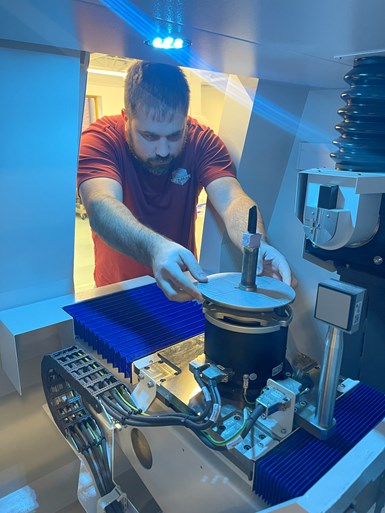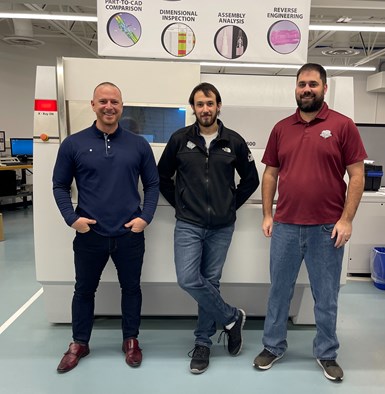
With computed tomography (CT) scanning and modified coordinate measuring machine (CMM) software, lead CT engineer Ryan Bergeron took on a challenging mold project and measured 700 dimensions in only a couple of minutes. Photos Credit, all images: 3D ProScan, NyproMold
Before investing in a Zeiss Metrotom 800 computed tomography (CT) scanner in 2011, one of the biggest problems at NyproMold was qualifying a mold to get it out the door. The Zeiss scanner’s most significant benefit is doing the CAD overlay part. So instead of performing a dimensional inspection, the user can take the CAD model, overlay it and see 100% representation in roughly an hour and a half. In the years to follow, computer software and hardware updates significantly reduced scan times by 70%.
The CT scanner’s capabilities and speed improved workflow and deliveries and became a launch point for 3D ProScan — a division of NyproMold, providing industrial tomography for plastic injection molding, medical devices, packaging and personal healthcare products. “We thought, ‘We have the machine, so why don’t we offer CT scanning services to companies with a need?’” 3D ProScan and NyproMold lead CT engineer Ryan Bergeron says.
Featured Content
“We’ll scan it, review it with the customer and if they like what they see and can use it, we will bill them,” Bergeron explains. “If they don’t like it and don’t get what they’re hoping for, then they learn something and we learn something. Then if they have another product down the line, they’ll keep us in mind.”
Bergeron even sold the idea to NyproMold’s project managers of using his team for the company’s CT scanning to run dimensional inspection reports instead of using a third-party contractor.
Most of the team’s work with the CT scanner is dimensional inspection with part-to-CAD because of the time savings it offers, especially if it’s a repeat job — it’s days instead of weeks or hours instead of a day.
The Zeiss machine’s price in 2012 was around $600,000; when you add in the software and training, you’re looking at almost $750,000. So, it’s a significant investment. Nevertheless, NyproMold maintains its original system, emphasizing the equipment’s robust qualities.
“We think, ‘If it ain’t broke, don’t fix it,’” Bergeron says. “We have the machine calibrated and PM’d regularly. We only had to replace the X-ray tube last year and that’s only because the manufacturer recommended it, as they’ve never seen a machine hit 15,000 hours. The life indicator service light was in the red, meaning we needed to replace the tube at a substantial cost.”
In addition to Bergeron, the 3D ProScan group includes a team of CT engineers and a dedicated sales and marketing manager. Most of the team’s work with the CT scanner is dimensional inspection with part-to-CAD because of the time savings it offers, especially if it’s a repeat job — it’s days instead of weeks or hours instead of a day. The team at Nypromold takes the print and does all of the dimensions or specific dimensions. They also get involved with assembly analysis.
“Our utilization isn’t at 100%, so there is still room to fill, but there’s never a point where I look over and there’s nothing in the queue. So our turnaround is typically three to five days,” Bergeron says.
Upgrades and Advances

NyproMold’s 3D ProScan team includes (left to right) sales and marketing manager, Jay Patterson, metrology lab manager, Jeremy Mallard and lead CT engineer Ryan Bergeron.
CT scanning is similar to conventional coordinate measuring machines (CMM), but CT scanning is nondestructive, which means parts don’t have to be cut. Plus, the programming takes as long as it would with a CMM. However, with a CT scanner, users can program ahead of time off of a CAD model; a CMM, can also be programmed ahead of time, but it’s more difficult to program because the parts are needed, as it uses a touch probe and, depending on the warp of the parts, may require a significant number of additional hits to locate features accurately. However, the CT scanner uses a virtual touch probe, so additional inspections do not require that much more time.
“The software we use is a conventional CMM software that is PTB-certified,” Bergeron says. “We have an extra module that allows me to import CT scan data. We use this software for dimensional inspection — part-to-CAD software — and we have another software that we use for assembly analysis, part-to-part and wall thickness.”
The company also performs reverse engineering. For example, the team will create an STL file in-house with Volume Graphics, but because STL is only triangles and not surfaces, they convert the file to the Creo, SolidWorks or IGES file that the customer needs.
Another CT scanner upgrade was the software to increase the scanning area. The CT scanner had a 5-inch cylinder to scan in, which rotated on a table, limiting scanning to 5 inches high, 5 inches in a circle and 5 inches wide. Now, with a software upgrade, Nypromold can stitch.
“We are still at that 5-inch cylinder, but now we can scan up to 15 inches in height,” Bergeron explains. “So, for example, we can take a ruler, and scan every 4 inches. It would then be three scans and the software stitches them together to make the whole part. So it allows us to scan long and narrow parts.”
“We only had to replace the X-ray tube last year and that’s only because the manufacturer recommended it, as they’ve never seen a machine hit 15,000 hours.”
The most significant advancement in CT scanning is the scan time, which has come down nearly 70% over the years through rounds of software and hardware investments. For example, one part had 700 dimensions on the print. It took almost a week to program. It was a 16-cavity tool. To measure it conventionally would take weeks because the 10 different cross-section views require the part to be physically cut. With CT scanning, Bergeron can put two of them in at a time with the scan, reducing it to 8 scans or a couple of hours of scanning — measuring 700 dimensions only takes a couple of minutes with the modified CMM software.
NyproMold’s CT scanner is built mainly for plastic or thin-walled metal like aluminum. They can scan some steel, but penetrating it isn’t easy. However, according to Bergeron, there are machines with triple or quadruple the power, size, voltage and current to which they refer customers.
NyproMold is continuously upgrading machines, so it wasn’t uncommon for the company to invest in the CT scanner 12 years ago. There continue to be enhancements with CT scanning, so Bergeron believes Nypromold has only touched the surface of possibilities.
RELATED CONTENT
-
Laser Welding Versus Micro Welding
The latest battle in finely detailed restoration/repair of mold materials.
-
Understanding the Effect of Pressure in the Cavity
Molders offer a moving target for moldmakers to adjust to by producing parts with different cavity pressures.
-
Surface Finish: Understanding Mold Surface Lingo
The correlation between the units of measure used to define mold surfaces is a commonly raised question. This article will lay these units of measure side by side in a conversion format so that companies can confidently understand with what they are dealing.
















